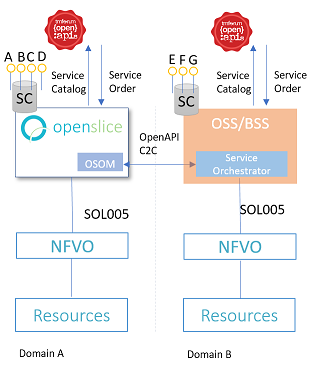# Architecture Openslice offers the following main functionalities: * Service Catalog Management: A CSP will have the ability to manage the Service Catalog Items, their attributes , organize in categories and decide what to make available to Customers * Services Specifications: A CSP will be able to manage Service Specifications * Service Catalog Exposure: A CSP will be able to expose catalog to customers and related parties * Service Catalog to Service Catalog: Openslice able to consume and provide Service Catalog items to other catalogs * Service Order: The Customer will be able to place a Service Order * Service Inventory: The Customer and Provider will be able to view deployed Services status The following figure displays the overall architecture of Openslice. [](../images/architecture.png) Openslice allows Vertical Customers browsing the available offered service specifications. It consists of: * Web frontend UIs that consist of mainly two portals: i) a NFV portal allowing users self-service management and onboarding VNFDs/NSDs to facility’s NFVO ii) a Services Portal, which allows users to browse the Service Catalog, Service Blueprints specifications and the Service Inventory * An API gateway that proxies the internal APIs and used by the web front end as well as any other 3rd party service * A Message Bus where all microservices use it to exchange messages either via message queues or via publish/subscribe topics * An authentication server implementing Oauth2 authentication scheme * A microservice offering TMF compliant API services (eg Service Catalog API, Service Ordering APIetc) * A microservice offering NFV API services (eg VNF/NSD onboarding etc) and allows to store VNFDs and NSDs in a catalog * A microservice that is capable to interface to an issue management system. For example it raises an issue to all related stakeholders (CSP, NOP, CSC) that a new Service Order is requested * Central logging microservice that is capable to log all distributed actions in to an Elasticsearch cluster * A Service Orchestrator solution that will propagate Service Ordering requests to the equivalent SOs and NFVOs The following figure depicts how Openslice microservices are deployed [](../images/microservices_network_deployment.png) ## Deploying Openslice in multi domain scenarios A typical deployment across domains, involves today some typical components: i) an OSS/BSS to allow customers access the service catalog and perform service orders, ii) a Service Orchestrator (SO) component for executing the service order workflow, as well as iii) a Network Functions Virtualization Orchestrator (NFVO) for configuring the iv) network resources. TMF Open APIs are introduced not only for exposing catalogues and accepting service orders, but also implementing the East-West interfaces between the domains, fulfilling also the LSO requirements as introduced by MEF. The following figure shows how openslice could be used in such scenarios: [](../images/multi-domain-architecture.png) See more [Consuming Services From External Partner Organizations](./consumingServicesFromExternalPartners.md)